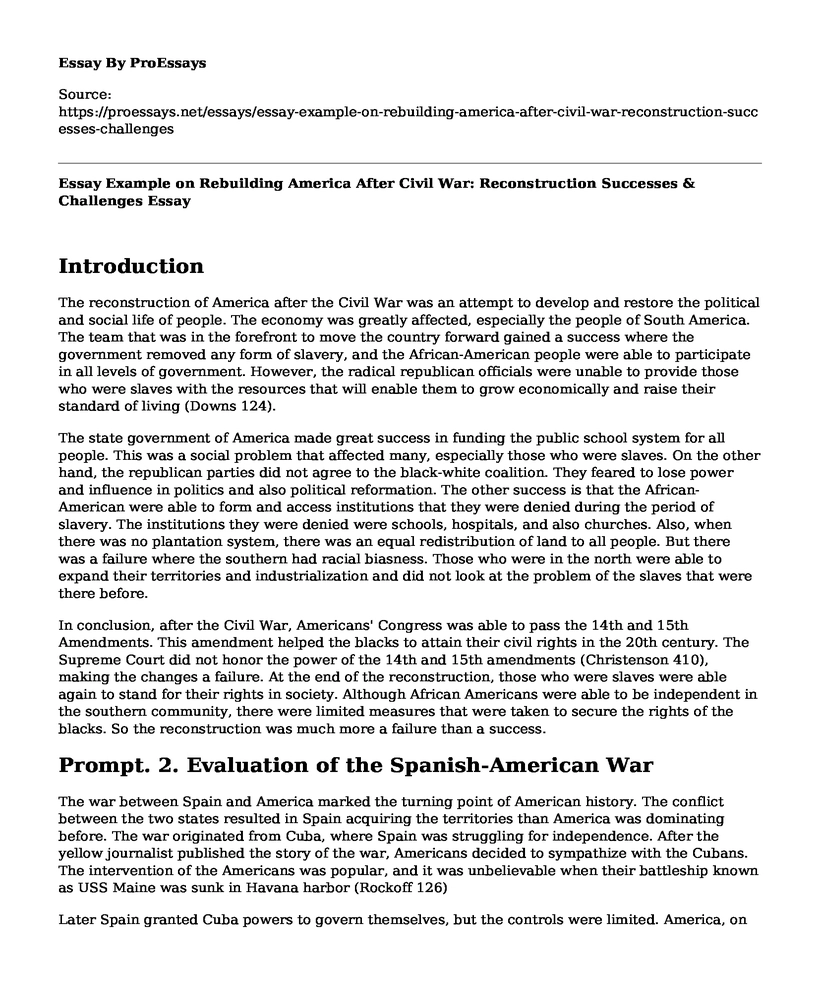Introduction
The reconstruction of America after the Civil War was an attempt to develop and restore the political and social life of people. The economy was greatly affected, especially the people of South America. The team that was in the forefront to move the country forward gained a success where the government removed any form of slavery, and the African-American people were able to participate in all levels of government. However, the radical republican officials were unable to provide those who were slaves with the resources that will enable them to grow economically and raise their standard of living (Downs 124).
The state government of America made great success in funding the public school system for all people. This was a social problem that affected many, especially those who were slaves. On the other hand, the republican parties did not agree to the black-white coalition. They feared to lose power and influence in politics and also political reformation. The other success is that the African-American were able to form and access institutions that they were denied during the period of slavery. The institutions they were denied were schools, hospitals, and also churches. Also, when there was no plantation system, there was an equal redistribution of land to all people. But there was a failure where the southern had racial biasness. Those who were in the north were able to expand their territories and industrialization and did not look at the problem of the slaves that were there before.
In conclusion, after the Civil War, Americans' Congress was able to pass the 14th and 15th Amendments. This amendment helped the blacks to attain their civil rights in the 20th century. The Supreme Court did not honor the power of the 14th and 15th amendments (Christenson 410), making the changes a failure. At the end of the reconstruction, those who were slaves were able again to stand for their rights in society. Although African Americans were able to be independent in the southern community, there were limited measures that were taken to secure the rights of the blacks. So the reconstruction was much more a failure than a success.
Prompt. 2. Evaluation of the Spanish-American War
The war between Spain and America marked the turning point of American history. The conflict between the two states resulted in Spain acquiring the territories than America was dominating before. The war originated from Cuba, where Spain was struggling for independence. After the yellow journalist published the story of the war, Americans decided to sympathize with the Cubans. The intervention of the Americans was popular, and it was unbelievable when their battleship known as USS Maine was sunk in Havana harbor (Rockoff 126)
Later Spain granted Cuba powers to govern themselves, but the controls were limited. America, on the other side, issued full self-governance of the Cuban government and directed the Spanish army to withdraw from the Cuban territory. Then the war was declared between Spain and America. The Spanish-American war came to an end when the two countries signed a treaty of Paris. Americans were the ones who won the battle and emerged as a superpower country. It also took a new stake in international politics that later determined its role in the affairs of European countries and the rest of the world.
Conclusion
After the war, the Americans expanded their territories where it started trading with the Asians. The trade earned the American merchants and manufacturers millions. This profitable trade made Americans have a more substantial influence on Asian countries (Graber 765). From an economic perspective, the war also benefited Spain. The flow of capital helped Spain to develop in its industries of textile and steel. When they were defeated in the battle by Americans, they started to weaken economically.
Works Cited
Christenson, Dino P., and David M. Glick. "Chief Justice Roberts's health care decision disrobed: the micro-foundations of the Supreme Court's legitimacy." American Journal of Political Science 59.2 (2015): 403-418. http://people.bu.edu/dinopc/papers/roberts.pdf
Downs, Jim. Sick from Freedom: African-American Illness and Suffering during the Civil War and Reconstruction. Oxford University Press, 2012: 124-126
Graber, Jennifer. "The Cross of War: Christian Nationalism and US Expansion in the Spanish-American War by Matthew McCullough." Register of the Kentucky Historical Society 113.4 (2015): 764-766.
Rockoff, Hugh. America's economic way of war: war and the US economy from the Spanish-American War to the Persian Gulf War. Cambridge University Press, 2012: 125-127. http://www.miwsr.com/2013-046.aspx
Cite this page
Essay Example on Rebuilding America After Civil War: Reconstruction Successes & Challenges. (2023, Sep 03). Retrieved from https://proessays.net/essays/essay-example-on-rebuilding-america-after-civil-war-reconstruction-successes-challenges
If you are the original author of this essay and no longer wish to have it published on the ProEssays website, please click below to request its removal:
- Ken Burns' "Forever Free" Essay
- The Effects of 9/11 Attack - Paper Example
- Research Paper on Early American History (1619 to 1877)
- Essay Sample on The Peloponnesian War: Sparta vs. Athens & the Ancient City's History
- Essay Example on Season of Migration to the North: Reflection of Modernism in Africa
- Essay Sample on Duke Ellington's 1965 Copenhagen Jazz Performance: A Night of Relaxed Excitement
- US Involvement in Vietnam War: Stopping Communism's Global Spread - Free Paper Sample







